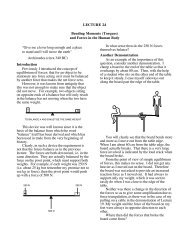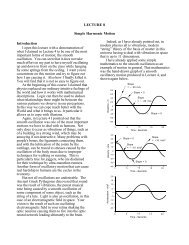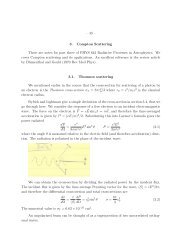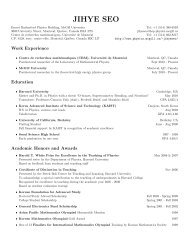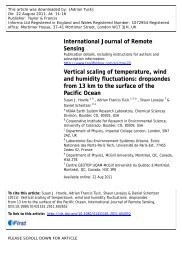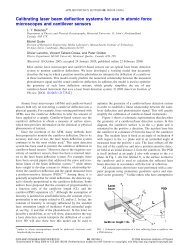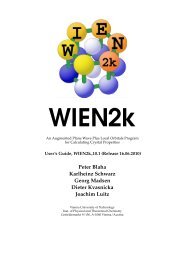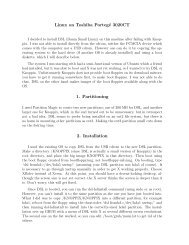Atomically defined tips in scanning probe microscopy - McGill Physics
Atomically defined tips in scanning probe microscopy - McGill Physics
Atomically defined tips in scanning probe microscopy - McGill Physics
Create successful ePaper yourself
Turn your PDF publications into a flip-book with our unique Google optimized e-Paper software.
AbstractIn this work we describe ultra-high vacuum fabrication of a nanoscale systemthat reveals Coulomb blockade at room temperature and its characterizationby s<strong>in</strong>gle-electron sensitive electrostatic force <strong>microscopy</strong> (e-EFM). The systemconsists of Au nanoparticles separated from an Fe(001) back electrode by a crystall<strong>in</strong>eultra-th<strong>in</strong> NaCl film. Due to the small size of the nanoparticles (3.5 nm high),the Coulomb blockade can be observed at room temperature. An atomic force<strong>microscopy</strong> (AFM) cantilever is used as a movable gate to charge <strong>in</strong>dividual nanoparticlesvia s<strong>in</strong>gle-electron tunnel<strong>in</strong>g from the back electrode. At the same timethe tunnel<strong>in</strong>g is detected by measur<strong>in</strong>g frequency shift and damp<strong>in</strong>g of the oscillat<strong>in</strong>gcantilever. The e-EFM technique can overcome limitations of other characterizationmethods based on lithographic fabrication. So far, however, it hasbeen successfully used only at low-temperatures. In this work, we extend thee-EFM technique to room temperature by carefully tun<strong>in</strong>g the sample design andfabrication relative to the cantilever response to achieve maximum sensitivity.To grow atomically <strong>def<strong>in</strong>ed</strong> tunnel barriers we <strong>in</strong>vestigate the morphologyof MgO and NaCl ultra-th<strong>in</strong> films on Fe(001) surfaces by non-contact-AFM andlow energy electron diffraction (LEED). First, we demonstrate that the quality ofMgO films, typically grown <strong>in</strong> ultra-high vacuum (UHV) by electron-beam evaporation,can be improved by us<strong>in</strong>g reactive deposition method that gives full controlover the gaseous species exist<strong>in</strong>g <strong>in</strong> the evaporated beam. Second, we <strong>in</strong>vestigatethe effects of temperature and oxygen presence on the growth of NaClon Fe(001). As a result, we develop a protocol to grow NaCl films on the Fe(001)-p(1×1)O surface <strong>in</strong> a layer-by-layer mode, yield<strong>in</strong>g atomically flat films with 40-60nm wide terraces (on a 12 ML thick film) and with far fewer defects than the MgOfilms.Us<strong>in</strong>g the NaCl film as a tunnel barrier that can be easily adjusted by modify<strong>in</strong>gthe film thickness we characterize s<strong>in</strong>gle-electron charg<strong>in</strong>g at room temperatureof <strong>in</strong>dividual Au nanoparticles formed after thermal evaporation onto a 6i



